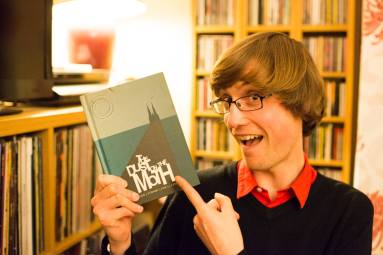In case you’re curious, here’s a quick update on Bees Make Honey’s Kickstarter campaign to publish The Dust on the Moth as a “multi-dimensional hardback”.
Actually, it’s not so much an update as a shameless copy-and-paste from an interview Kirsty Fox and I did for Nottingham’s Left Lion. I know – it’s lazy and I should try harder. But we all need to recycle wherever we can. Plus things are busy-busy-busy, time is short and time is money and money makes the world go round et cetera et cetera.
Why choose to crowdfund a book in this way?
Kirsty: I’ve been wanting to try out crowdfunding for a while. Part of what I do with Bees Make Honey is advise people on things like funding options and it’s much easier to advise someone if you have cold hard experience to go on. I choose book publishing because it’s one of my passions and because publishing is big upfront costs with uncertain return.
I learned this the hard way with the first book I published – I still have a hundred odd copies with no loving home to go to. The appeal of this is working out demand before you supply. If we’re successful Darren’s book will be in people’s hands being read and loved, not sat in my attic gathering poetic dust.
Darren: And there’ll be a lot to love – it’s going to be quite a lavish book. The decision to produce a hardback with colour artwork was partly guided by the desire to produce something physical and beautiful for people to own and treasure. In some ways it’s a reaction to the pervasiveness of digital content – which is great in many ways, but right now there’s a growing, almost fetishistic appreciation of more tangible objects. You only have to look towards the return of vinyl to see this.
But producing physical colour hardbacks isn’t cheap. Hence crowdfunding seemed to be the way to go. We’re hoping that people will be interested in being part of and investing in the production of something special.
Why this book?
Darren: The Dust on the Moth seems to fit in so well with Bee’s Make Honey’s mission. The novel actually had a tricky time in finding a home. Several literary agents and indie publishers really liked it but felt unable to handle the fact that it doesn’t fit neatly into a specific genre. But this happened to be exactly what Bees Make Honey were looking for: fiction that defies categorisation and gives two fingers to pigeonholes. So they had a gander and took it on, and now we’ve ended up with this hugely ambitious campaign.
Kirsty: I like Darren’s writing because he’s not afraid to take risks and have fun. There’s a rawness which traditionally published books tend to lack because they’re edited differently and are too self-conscious of their market. It’s like when you get a really good piece of music that’s overproduced. The Dust on the Moth takes an idea and runs away with it in ways that are both incredibly silly yet also still profound. It makes you laugh while also potentially giving you an existential crisis. I think that might be my favourite kind of art when it’s done well. Also, as a person to work with, Darren is very self-motivated. When I first met him, he was putting out illustrated short stories as Panspermia Press with illustrations from his friend Chris Baldwin. He was already collaborating and experimenting in order to get his work out there.

The Kickstarter is over halfway done: how are things going with it?
Darren: We had an amazing start in which we got over a grand in just two days. But things have slowed down and we still have a way to go before meeting our £5000 target; failure to meet the target means we get none of the money pledged at all. This doesn’t seem to bode well, but actually represents a pretty common course for Kickstarter campaigns. A lot of campaigns get a depressing dip in the middle and then shoot up at the end to meet their target. So we’re hoping to start seeing that soon, especially with people’s impending paydays and the growing jeopardy factor. It’s playing out a little like an indie underdog story – I think that’s one of the things people like about crowdfunding projects like this.
Kirsty: It’s just like The Mighty Ducks. Except we can’t express our frustration with hockey sticks.
Darren: Beyond the financial side of things, the response from people has been fantastic. It’s humbling and wonderful to discover how supportive your friends and family are, and alongside this you get the backing and enthusiasm of total strangers, which is particularly rewarding.
What’s involved in the day to day running of a Kickstarter? Is it just a case of launching one and then keeping your fingers crossed?
Kirsty: Absolutely not. Anyone who uses that technique is likely to fail hard. You can’t expect the world to magically find your campaign amidst hundreds of others. There are people who browse Kickstarter looking for interesting things, but they’re not likely to see your campaign unless you’ve got off to a good start. You have to be on social media every day, trying to shout about it without repeating yourself too much and pissing people off! It’s hard work and tough on the ego too. It’s a huge benefit to do it as part of a team of four because you can keep each other’s spirits up, but I still feel the most responsible.
Darren: I mostly do what I’m told. This means distributing flyers, regularly promoting the campaign on Twitter (look out for #KICKSTARTMOTH) and guilt-tripping my friends and family into having a look, spreading the word and maybe even chipping in. At the more strategic level I get together with the Bees Make Honey team to discuss tactics and leave biscuit crumbs on Kirsty’s sofa. Recent tactics include a free prize draw for all pledgers and two new reward options: Bees Make Honey lucky dip bags crammed with goodies and personalised short stories on the subject of the pledger’s choice.

Tell me about The Dust on the Moth. It seems to be a lot more than just a book.
Kirsty: We’re very aware of the decline in print publishing and the reasons why that is happening. We were also keen to do something collaborative and experimental because we’re the kind of people who lay awake at night with too many fantastic ideas buzzing around. The Dust on the Moth lends itself to experiment, so it just felt right to elaborate on the worlds Darren had created by giving the book extra dimensions. So we have illustrations by Dan and photographs by Phil, and they’re ‘world-building’ rather than taking things literally. They pick up on abstractions and less tangible aspects. There’s also a ‘soundtrack’ written by Dan in collaboration with Graham Langley of Savoy Grand.
We are also interested in digital experimentation and we’d love to make The ‘Moth into an even more multi-media project with moving image and an interesting platform – something much more than a bog standard e-book. But there are currently not enough hours in the day, nor money in the bank for this. So for this episode we’re mainly expressing our love of the printed book.
Darren: You could even say it’s more than a book at the narrative level. It’s two books in a way: two very different stories that become progressively tangled as you go along. Overall, I really hope the campaign is successful so that readers and art fans will have the opportunity to discover a unique book that goes way beyond the sum of its parts.
Kirsty: Many thanks to everyone who has contributed so far. If you like the sound of the project please help us out towards getting it funded. Even just sharing it and helping get the word out is much appreciated! Follow the hashtag #KickStartMoth.
Kirsty Fox is a social entrepreneur, writer and creative producer with Bees Make Honey Creative Community. Darren Simpson is the author of The Dust on the Moth. The Dust on the Moth is a collaborative project with an illustrator, Dan Layton and a photographer, Phil Formby.
The Dust On The Moth on Kickstarter
Bees Make Honey website














